Greetings!
WELCOME TO DAYLILY E-NEWS, a free electronic newsletter brought to you by the American Hemerocallis Society, also known as AHS. Daylily E-News is for all who share an interest in daylilies, including members of the American Hemerocallis Society and other horticultural organizations, educators, garden writers, news media, and others who love to garden.
We are privileged this issue to have an article by Sydney Eddison, the nationally known gardener, author, and speaker whose garden has been featured in countless magazines and television shows. Her book, A Passion for Daylilies, is a classic among daylily lovers, and her latest book, Gardening for a Lifetime, is filled with her wisdom from years of experience. Our featured photographer this issue is Tim Fehr. Tim lives in Eau Claire, Wisconsin. He started growing daylilies in the mid-80's but got seriously hooked in the early 90's. He has been the webmaster for the AHS since 1996 and founded the AHS's 1,300 member E-Mail Robin in 1994. Tim received a B.F.A degree in painting from the University of Wisconsin and has been an avid photographer since high school. Tim works as a technical support specialist for school districts in west-central Wisconsin.
If you are not yet a Daylily E-News subscriber, sign up via the link at the AHS website: Daylily E-News.
For much more about daylilies and daylily events, visit the AHS website (see QUICK LINKS on the sidebar). A comprehensive Site Map is available on the site.
You may unsubscribe from Daylily E-News at any time by clicking on SafeUnsubscribe, which you will find in each issue.
We hope you enjoy Daylily E-News!
Elizabeth Trotter E-News Editor
|
|
Our sponsor for this issue of E-News is Slightly Different Nursery. Thank you for your support! |

For daylilies!
To find a meeting in your area, visit:
|
|
Region 6 Meeting
Hosted by Albuquerque Daylily Society
June 30 - July 2, 2011
Albuquerque, New Mexico 
Region 6 Meeting
|

2011 Region 4 Peak Bloom Meeting
July 15-17, 2011
Gueph, Ontario |
|
Order your AHS Publications today!
Judging Daylilies filler pages (filler only) can be purchased from AHS Publication Sales for $16.00 postage included. The filler is sized for a standard 3-ring binder. Also The Cumulative Awards and Honors Booklet is NOW available for $10.00, postage included for shipment within the United States. International members are billed slightly more to cover the cost of postage.
Each year the AHS publishes a membership brochure featuring beautiful new photos of the year's daylily award winners. Daylily clubs can order up to 100 brochures free of charge and pay only for shipping. Others can order 100 brochures for $12.00 (U.S. funds; shipping within the U.S. included).
Other AHS publications are also available. The AHS Registration Checklist on CD-ROM has been updated with all the 2009 daylily registrations and pre-registrations. PC and Macintosh versions come on the same CD for $27.00 (U.S. funds; shipping within the U.S. included). Visit the AHS Publications webpage for more information or contact:
American Hemerocallis Society
c/o Jimmy Jordan
276 Caldwell Drive
Jackson TN 38301
731-422-2208
AHS Publications Manager
Make all checks payable to the American Hemerocallis Society. U.S. orders are postage paid. International orders are welcome, but please remit U.S. funds and include additional postage to cover shipping.
|
|
Not yet a member of AHS? Join today and receive a valuable daylily voucher!
AHS membership includes the fabulous quarterly Daylily Journal, jam-packed with informative articles and colorful photos, plus your regional newsletter at no additional cost.
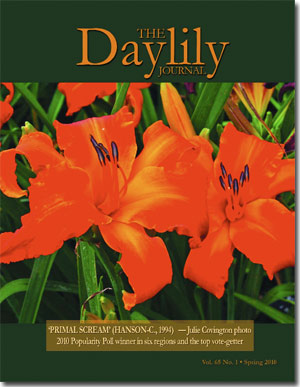 If you join AHS as a new member before September 2011, you will receive a voucher worth $25 or more to use with a participating daylily vendor. If you join AHS as a new member before September 2011, you will receive a voucher worth $25 or more to use with a participating daylily vendor.
This popular program debuted in 2007, and vendors have agreed to continue for 2011. Current AHS members who upgrade their membership to a higher level will also qualify for a voucher.
Vendors may require a minimum purchase, and some vendors may offer a voucher of higher value than others. Members must pay shipping (and phytosanitary certificates where applicable).
A member may receive a voucher one time only. Upon receipt of your membership application, the AHS Executive Secretary will send you a voucher along with a list of participating vendors.
Join AHS today and discover the exciting world of daylilies!
|
|
Ask the Ombudsman

Donna Peck has been the Ombudsman for the American Hemerocallis Society for the past three years. An Ombudsman "is an independent, neutral party who is able to look at problems that come up in an unbiased fashion." The Ombudsman also answers questions about Society rules and procedures. Donna has been writing Ombudsman columns for regional newsletters and the Daylily E-News, and now the columns are available on the AHS website. In this series of columns, she will answer a question that may benefit not only the member who had the concern but others as well. If you have a problem, question or situation with which you need help, contact Donna at AHS Ombudsman.
ASK THE OMBUDSMAN - Ideas for Club Meetings....Part 2
QUESTION: What are some ideas that can make our local club meetings interesting, educational and enjoyable?
This question has been asked by a number of program chairs. I put ten ideas in Part 1 of my Ask the Ombudsman column, and here are another ten. I hope they will help your clubs have a successful year.
RESPONSE:
1. This suggestion is similar to the first one in the last Ombudsman column, but it is so important: Make your members feel welcome. Greet members at the door. One club designates club greeters to do this. Always announce new members at your meetings. If you have guests, announce them also. Remember they are potential new members. Joe Goudeau says, "Do not be above bribery to gain new members." Give new members and even guests a new daylily. Follow through with a personal note welcoming them after the meeting.
2. Get your veteran members as well as the new members involved. Don't wait for them to volunteer; ask them personally - not by email - to help out. Members like to feel they are a part of something. If members miss a meeting, call them and make sure they know the date of the next meeting. One club has postcards and passes them out with names of those missing the meeting. A member at the meeting chooses a card and crosses out the member's name that s/he is going to send the card to. Can you imagine how delighted the member will be to receive that postcard?
3. This suggestion might not seem important, but have name tags with not only members' names but also the office(s) they hold printed on them. Put their addresses on the labels, because it will be surprising how many members live near each other and could carpool to meetings and other events.
4. This isn't as stuffy as it sounds: have a book review at your meeting. Assign a gardening book to four or five people, then have those members report on the sections that were assigned to them. I did a report on a book called 100 Flowers and How They Got Their Names. I assigned various members to report on three or four of the flowers which I thought to be the most interesting ones. At the end of the meeting we drew a name, and that member won the book! Other excellent daylily books that would make great meeting reviews are A Passion for Daylilies by Sydney Eddison, The New Encyclopedia of Daylilies by Petit and Peat, and Delightfully Delicious Daylily: Recipes and More by Peter Gail, to name a few.
5. Have you tried Daylily Bingo? Our program chairman tried it for one of last year's meetings and the members enjoyed it. She was able to obtain 7 or 8 daylilies from a hybridizer at a much reduced rate. She just bought an inexpensive bingo set at a toy store and used that. Every member received one free card. If the member wanted to have more than one card s/he would have to pay an extra $3.00. Your club could make up your own rules about how many cards and how much to charge. We just played bingo and whoever won received a free daylily plant.
6. This next idea one club called "Adopt a Plant." Have your club buy a couple of current collections. Give them to members to grow during daylily season and at the end of the year have them return a couple of fans for an auction. The proceeds will return the money paid to buy the collections back to the club. If the daylilies need an extra year to grow, then have the auction the following year. It's an excellent way to get new daylilies in the members' gardens for a reasonable price.
7. The North Texas Daylily Society has another idea for distributing a new collection from a hybridizer. They use the daylilies each meeting as a door prize drawing. Everyone is eligible. According to Gwen Pennington, a member of NTDS, "This puts newer introductions in the hands of members who might not be able to afford these plants." The president started this practice and he takes care of the plants until he brings them to a meeting.
8. Wanda Evans, President of the Greater Cincinnati Daylily and Hosta Society, suggested a "show and tell" meeting. This could be in the winter when we are all missing our daylilies. Assign a few members to take pictures of their garden, especially close-ups of their favorite daylilies. At a winter meeting, have the members show the pictures and tell about their gardens. Each member needs to have only about five minutes to show his or her pictures and tell about them.
9. Wanda had another good idea about having the founding members or other knowledgeable members talk about their club history. Her club talked about how their group was started, who was behind some of the awards they give out each year, and some of the members who gave a lot of time to the club and what they accomplished. It would be good to have the history written out in pamphlet form to give all new members to read when they join.
10. Gail Rasberry from Arkansas suggests that some of the AHS Robin members discuss a sampling of the Robin issues. Think of the various subjects that could be discussed. A member could actually print out various subjects and views the Robin members have. A few subjects I think your clubs would enjoy discussing that were discussed recently were:
-Unregistered daylilies
-Control of garden gnats, deer and other creatures
-Germinating daylily seeds.
-Favorite daylilies in each color group
Actually I am on our club's program this year concerning questions I have received as AHS Ombudsman. My club is curious about what I do, so I will distribute a series of questions and my responses to them.
I'm afraid I just couldn't stop with 10! Here is one more from Nikki Schmith. I liked her idea of an off-scape show. If your gardens are small and the members are hesitant to cut their new scapes, have them bring just the daylily flower and have an off-scape show. This wouldn't be AHS accredited, but would be fun and educational to see the various daylilies. You'd need special vases or glasses to hold the off-scape daylilies.
I hope these ideas help. If you missed Part 1, log on to the AHS website at www.daylilies.org. In the left hand corner, click on Ask the Ombudsman. You will find the articles which have been published so far, and one is entitled "Ideas for Local Club Meetings." Or, go to the Daylily E-News Archives and view the February 2011 issue at Daylily E-News.
I would also like to write Part 3, so keep your ideas coming to me at: ombudsman@daylilies.org.
|
|
Desirable Daylilies
Discover what separates the best from the rest
by Sydney Eddison
A daylily of her own: The daylily 'Sydney Eddison' was named for the author by Alabama hybridizer Sarah Sikes.

In 1990, I wrote a book about daylilies, and every year since I've written something about these wonderful garden perennials. So, when asked recently if I ever got tired of writing about them, the answer was a resounding "No!" Let me explain. Daylily people don't get tired of daylilies. We are an evangelical lot, and enjoy nothing more than proclaiming the gospel.
I was an early convert to the joys of growing daylilies, having discovered their charms when I first began gardening in 1961. By chance, a daylily catalog found its way into my mailbox that spring, and I placed my first order on April 11. When the plants arrived on May 8, I was shocked to see sprawling, fleshy roots unprotected by soil and fans of foliage cut back to 8 inches. I later learned that daylilies are always shipped that way. In my old garden notebook, I observed that the new plants looked "brown and beat up." But once planted, fresh leaves soon emerged from their crowns. By midsummer, they were all in bloom, and I was hooked.
The next spring, this confession appeared in my notebook: "I've gone 'daylily mad' and ordered 12 'Hyperion', 12 'Sweetbriar', and three 'Pinafore' to add to the collection." I still have these three cultivars. I love my oldies. They are healthy, handsome, and vigorous, and have given me thousands of flowers over the years.
Daylilies come in different sizes, shapes, and colors
The botanical name for daylilies, Hemerocallis, is derived from two Greek words, hemera meaning "day," and kallos, "beauty." The plants more than live up to their botanical name: individual flowers last only one day, and they exemplify beauty in all its poignant brevity. Though each flower is short-lived, a good-sized plant can produce hundreds of blossoms over a period of several weeks. Besides their glorious blossoms, daylilies also have stout hearts and strong constitutions.
Daylilies come in an ever-expanding variety of shapes, sizes, and colors. From left, clusters of 'Linda', 'Audacity Bound', and 'Shining Plumage' illustrate only a part of the spectrum.
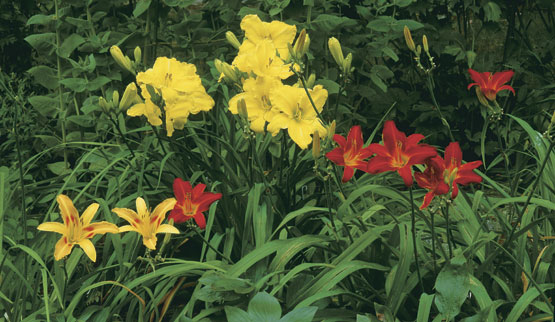
To find great daylilies, scout a display garden near your home
Acquiring daylilies that excel in the garden is usually a hit-or-miss affair. You receive a catalog full of mouth-watering color photographs, fall for a picture, and order a plant. That's what I did. But there is a better way.
You can visit the Web site of the American Hemerocallis Society (www.daylilies.org) and find a list of daylily display gardens in your area. Seeing daylilies in a local display garden is the only reliable way to choose the best cultivars for your region. Any cultivar growing lustily in the display garden will perform well in yours.
Assuming you locate a nearby daylily garden, go at peak bloom - late May in the Deep South to mid-July in the Northeast - armed with a little notebook and a pencil so you don't forget which cultivars you liked best.
Seek petals with pizazz - Qualities to look for in the flowers themselves are substance and sun tolerance. Substance can be defined as firmness in the actual petal tissue. A flower with good substance feels like heavy vellum. Some cultivars melt in the sun by midday. Their petals become almost transparent as the tissue breaks down, and dark reds sometimes turn black and slimy-looking in full sun. So, if possible, visit at different times of day to see how the flowers fare.
Foliage types are clues to a daylily's hardiness - Daylily foliage is categorized by its winter behavior in these three types: dormant, evergreen, and semievergreen.
Select plants with handsome foliage. 'Dixie Hummingbird' has handsome, strappy leaves in scale with the rest of the plant so it adds to the plant's overall appearance.
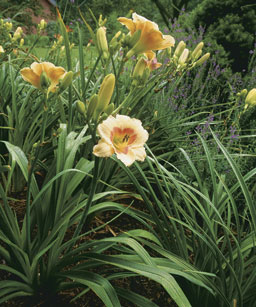
Dormant foliage dies to the ground at the onset of winter, the plants form resting buds at the crown and, in spring, send forth new leaves. On the whole, cultivars with dormant foliage are the most cold tolerant. Evergreens are the least cold tolerant - they do not form resting buds and, in warm climates, produce leaves all year. But hardy evergreens - and there are a good many of these - behave like dormants when grown in the North. In winter, their foliage dies to the ground. Daylilies with semi-evergreen foliage tend to retain their leaves in the South and lose them in the North.
As the breeding of daylilies has become increasingly complex, the lines of foliage type have become blurred. So has the hardiness issue. But, in general, Northern gardeners ordering from catalogs would do well to stick to dormant daylilies. Southern gardeners have a greater choice - evergreens or semi-evergreens. Some dormant daylilies do well in the South, but many pine for their cold requirement, dwindle, and eventually die in a too-warm climate. The only foolproof way to select the daylilies for your climate is to make your choices at a local display garden or nursery.
Plant daylilies alongside delicately textured perennials
Although I am a daylily person through and through, I am also a gardener. So, once I get my daylilies home, I feel they are at their best in the company of other plants rather than planted in separate beds. They are stalwart enough to hold their own with shrubs and look lovely against a background of red-twig dogwood (Cornus alba 'Elegantissima'), with its green-and-white-variegated leaves.
Among the most effective perennial partners are the ornamental grasses, with their delicate textures and neutral colors. Against them, the large, handsome flowers of the daylilies form bold patterns that change from day to day as new flowers open. The grasses fill the negative spaces between blossoms and weave the daylilies into the fabric of the garden as a whole.
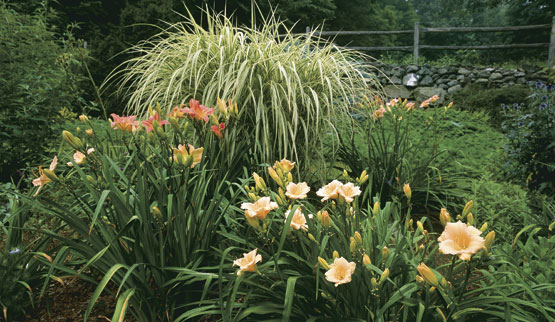
Ornamental grasses are an effective perennial partner for daylilies because they provide a pleasing background for the flowers' ever-changing patterns of bloom. Charming but short-lived blue flax (Linum perenne) and cultivars of Coreopsis verticillata combine well with miniature and small-flowered daylilies and perform a similar role - their fine, dense foliage fills in among the daylily clumps and also hides the yellowing outer leaves after bloom. Other fillers include bronze fennel (Foeniculum vulgare 'Bronze Form') or annuals like love-in-a-mist (Nigella damascena), and cupflowers (Nierembergia hippomanica). Even R. W. Munson, Jr., the acknowledged dean of daylily hybridizers, combined his cultivars with other plants at Wimberlyway Gardens, his home in Gainesville, Florida. There, under a tall canopy of pines and sweet gums, seemingly endless daylily beds cover the level landscape like a vast, multicolored patchwork quilt. The beds are backed by hollies and azaleas, edged with liriope, and accented with evergreens. It was my privilege to tour this garden with its creator, and to learn from the master what makes "a good garden daylily." He should know. He had been breeding daylilies for nearly 50 years. During that time, he contributed to dramatic changes in color and variety of forms, while maintaining vigor and stamina in the plant. When he gave me his definition of a good garden daylily, he emphasized these qualities: "It should be healthy, happy, and develop into a nice, symmetrical, rounded clump with lush foliage and numerous flowers on strong scapes." He singled out one that met these criteria: "Look at its stem," he said. "It's branched and heavily budded--the flower is held above the foliage, and the flower petals are wide and overlapping. That's my kind of daylily." Mine, too. An ever-evolving carnival of colors and shapes In addition to dozens of old daylily favorites in my garden, I have an embarrassing number of newer daylilies, and a few cutting-edge cultivars with luxurious ruffling around their broad petals. All told, I must have about 300 cultivars. I grow daylilies in all colors and shapes, and in heights ranging from a diminutive 12 inches to a statuesque 5 feet, and I'm not even a serious collector. Serious daylily collectors think nothing of growing 700 or 800 cultivars, and even they cannot hope to have every kind of daylily. This is a flower of endless variety. Daylilies come in colors ranging from sunrise yellow to sunset red - The solar spectrum boasts only six colors; daylilies offer hundreds. Suffice it to say, the original Hemerocallis palette of yellow, orange, and red has expanded dramatically, thanks to the efforts of hybridizers. Colors now include yellows from palest primrose and chartreuse on the cool side to chrome yellow and gold on the warm side. You can have oranges in Day-Glo or bronze, or in fruit flavors like apricot, tangerine, and cantaloupe. Reds run the gamut from a dark, almost black, red to pure cardinal. There are also purples, lavenders, pinks, and oh-so-close-to-whites. And this is only the beginning of the daylily's diversity. 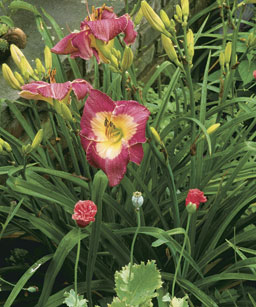
A watermark shines like a beacon on 'Malaysian Monarch' There are also different color patterns, such as a "watermark" (a pale aureole of color at the center of a darker flower), a "halo" (a faint, lightly etched contrasting or darker shade of color), and an "eye zone" (a darker or contrasting coloration on both petals and sepals at the throat of a lighter-colored flower). If it appears on the petals only, it's a "band." At the moment, eye zones, especially two-tone eye zones, are "in." So are eye zones with matching petal and sepal edges. In some of the most glamorous new flowers, a base of pale beige or creamy pink sets off eye zones and edges of deep red or purple. A relatively new development in daylily ornament-a fine thread of color, usually gold, around the rim of the petals and sepals-is called a "wire edging." Daylily blossoms are shaped like circles, spiders, or even trumpets - Narrow-petaled "spiders" weave a web of visual intrigue that snares some collectors. This unnamed cultivar is a cross between 'Open Hearth' and 'Kindly Light'. 
Diversity among daylilies isn't limited to color - their forms are infinitely varied, too. As a member of the lily family, the genus Hemerocallis shares certain physical traits with true lilies (Lilium): both have flowers with three inner segments, or petals, and three outer segments, or sepals - botanically, all six are "tepals." The arrangement and carriage of these six segments determines the flower's form. [Since publication of this article, daylilies have been moved to the family Hemerocallidaceae. - Editor's note] In many daylily blossoms, the sepals are narrower than the petals. But there are also cultivars with all six segments about the same width, and narrow-petaled "spiders" with petals at least four times as long as they are wide. Viewed head on, flowers can be either round or roughly triangular. In profile, the blossoms can be flat, trumpet-shaped, or something in between. Flower sizes run from miniature (less than 3 inches across) to large (anything over 4-1/4 inches). Photos: Steve Silk Reprinted with permission © 2011, The Taunton Press, Inc. Fine Gardening issue #56, August 1997 |
|
The American Hemerocallis Society, Inc., is a non-profit corporation organized exclusively for educational and scientific purposes, and especially to promote, encourage, and foster the development and improvement of the genus Hemerocallis and public interest therein.
|
AHS Daylily E-News Committee: Elizabeth Trotter (KY), Editor, E-News; Sue Bergeron (ON, Canada); Mary Collier Fisher (MA); David Kirchhoff (KY); Lynn Stoll (IA); Maureen Strong (ON, Canada).
|
| Daylily E-News © 2011 by the American Hemerocallis Society, Inc. |
|
|
|

Thanks to Slightly Different Nursery for sponsoring this issue of Daylily E-News. | |
| | |
|

Hemerocallis 'Geaux Tigers' (Goudeau, 2009). Click photo for larger image.
SPELLING LESSON
| |
How to spell
"daylily"
| |
The word "daylily" is properly spelled as one word. Many of today's spellcheckers and media style books incorrectly use the old-fashioned spelling "day lily" instead. The single word has been the preferred spelling for decades.
|
 | | Locate an AHS group near you! | |
The American Hemerocallis Society is all about daylilies and people.
AHS is organized into 15 Regions including USA, Canada, and International designations. Each offers a variety of regional and local club daylily activities.
When people join AHS, they also become a member of the AHS Region in which they live. AHS Regions do not charge additional dues. Most AHS regions publish their own newsletter and mail it to all regional members at no extra charge. Members often participate in events outside their own region.
To learn about daylily activities and events near you, visit the webpage:
AHS Regional Activities
|
 | | The AHS Media Library | Easy programs for your club--
OR...
add your presentation to the Library!
By Nikki Schmith
AHS Media Librarian
AHS Region 2, Michigan
One benefit of your American Hemerocallis Society (AHS) membership is access to rental programs from the AHS Media Library for club presentations, public education events, and personal use.
Over the last decade or two, AHS collected and organized presentations on traditional slide media and made them available for rental to AHS members. Many members took advantage of this easy way to offer entertaining and educational programs to their clubs.
In recent years, we saw a decline in the rental of these traditional 35mm slide programs. In the interest of supporting our educational mission and providing more people access to these programs, a conversion to digital media began.
Today, rental programs are available on CD in Microsoft (MS) PowerPoint format. Each program has a $10 rental fee (unless indicated otherwise); return postage and insurance are not included.
For a listing of programs currently available, go to:
AHS Media Library
There are several great choices, but with an organization our size, we should have more: more to provide to outside, like-minded organizations to spread the news about daylilies; more to provide to local clubs to continue the excitement about daylilies; and finally, more to document where we've been, because we are headed into the future so fast.
With the exception of the classic Sarah Sikes presentation, "Gardening with Daylilies," all of the original 35mm slide programs have been archived and are not available for rental at this time. Some are being considered for digital conversion in the coming years, while others will reside in the AHS archive.
If you have developed any programs, please consider sending a copy to the AHS Media Librarian if you are willing to have it rented to members. You can allow such use without giving up your copyright to the images if that is a concern to you. A Deed of Gift form can be provided in that case, covering the use and disposition. No special formatting or programming is required. You could simply send in a CD of labeled images or a completely formatted and animated PowerPoint. You could send in a presentation you've done on hybridizing, dividing, planting or designing with daylilies. You could send in a presentation on conducting a daylily exhibition. The possibilities are endless!
If you are interested in the library in any way, such as donating, renting, and volunteering to help, or if you have questions, please contact the Media Librarian, Nikki Schmith at AHS Media Librarian, or call 248-739-9006.
We look forward to a deluge of presentations!
|
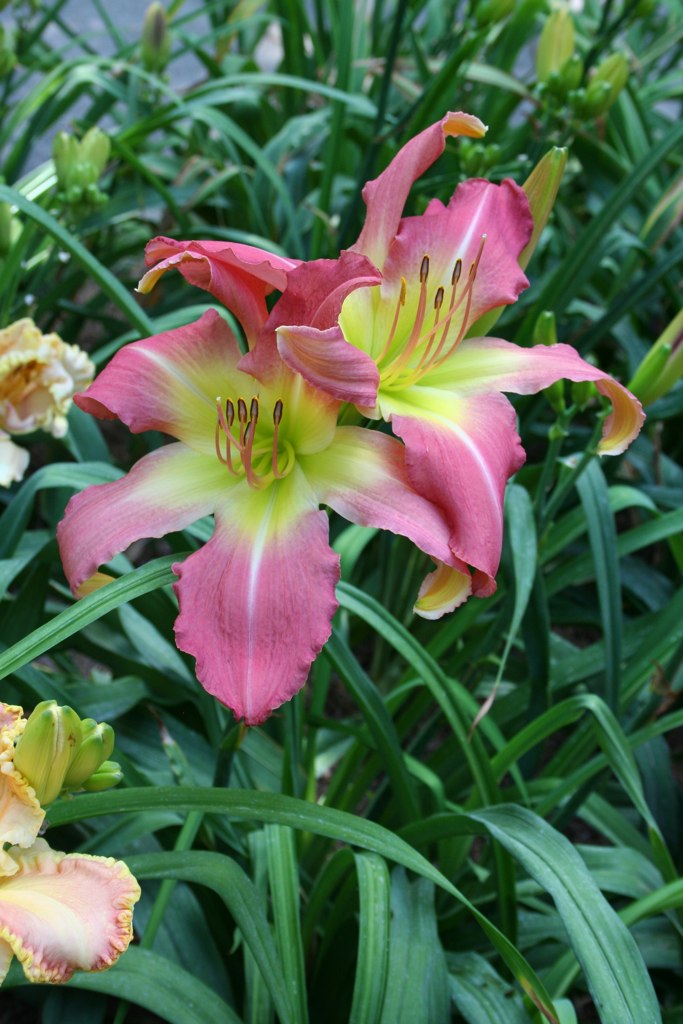 Hemerocallis
(Wilkerson, 2008). Click photo for larger image.
| |
Why Join AHS? | Learn about daylilies.
Receive the quarterly publication, The Daylily Journal.
Receive a regional newsletter 2-3 times per year.
Meet daylily growers and hybridizers.
Vote for favorite daylilies in the Popularity Poll.
Participate in daylily exhibitions.
Become an AHS Exhibition Judge.
Become an AHS Garden Judge.
Have an AHS Daylily Display Garden and/or AHS Historic Daylily Display Garden.
Attend daylily symposiums, garden tours, meetings, conventions, and more.
Participate in on-line discussion groups.
Join special interest snail-mail groups.
Become a better gardener.
Form friendships for life!
AHS members belong to one of 15 U.S./Canadian regions. Those outside the U.S. and Canada may join as International members. Over 180 local clubs form the backbone of every region, and you may find that one of them is near you. If not, meet with local gardeners and form a daylily club of your own!
It's easy to become a member. Just use this link: Join AHS
|
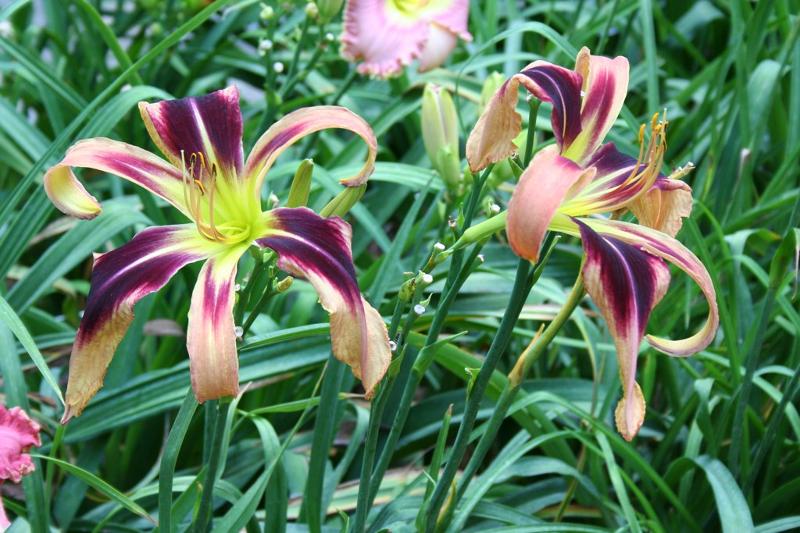 Hemerocallis
(Trimmer-J., 2008). Click photo for larger image.
| |
Would you like to reach over 2,700 garden and daylily enthusiasts?
Advertise in the Daylily E-News!
To learn more about advertising in the Daylily E-News, click
| |
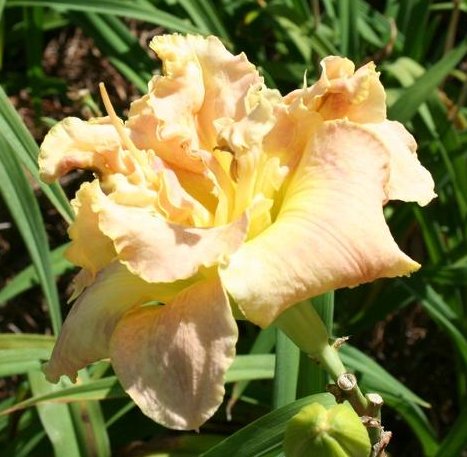
Hemerocallis 'Audrey Hepburn' (Kirchhoff
2004). Click photo for
larger image.
| |
What is a Daylily? | A daylily is an herbaceous perennial that will return year after year in a suitable climate. Some are evergreen and will retain their green foliage throughout the year in a mild climate.
Daylilies may be hardy or tender, depending on genetics, so gardeners should choose cultivars based on their local growing conditions.
Daylilies belong to the genus Hemerocallis, from the Greek meaning "beauty for a day." A typical daylily bloom lasts for one day, but an established clump will produce many flowering scapes with plentiful buds that will produce a fresh flush of blooms over many days.
Daylilies do not form bulbs (as do members of the genus Lilium, otherwise known as "true" lilies).
Due to the distinctive characteristics of Hemerocallis, taxonomists have removed daylilies from the family Liliaceae and placed them in their own family Hemerocallidaceae.
Daylilies form a crown, with fibrous roots below and foliage and flowering scapes above. The daylily crown is the essential growth center of the plant. Neither true daylily root structures nor daylily foliage will grow without a piece of the crown.
Some daylilies form rhizomes -- special underground structures with scales and internodes -- that can produce new plants. The species or "wild" types often have this trait. Many modern hybrids do not form rhizomes, although there are some that do.
For more daylily terms, see the AHS Daylily Dictionary.
|
|
Daylily Registrations
The AHS Registrar handles all registrations of new daylily cultivars for AHS, which is the registering body for all Hemerocallis worldwide under rules for the International Code of Nomenclature for Cultivated Plants (ICNCP).
Registrations may be made on line or by mail. For more information, see:
Daylily Cultivar Registration
Questions?
Contact:
Kevin P. Walek
9122 John Way
Fairfax Station, VA 22039-3042
703-798-5501(cell)
703-646-4904 (home-office)
OR Send email to:
Registrar
|
|
|
|
International Seed Bank
International daylily enthusiasts are welcome to request seeds from the AHS International Seed Bank. The aim of this
outreach program is to spread the interest in growing and enjoying daylilies around the world.
For more information, please contact Maureen Strong at
Seed Bank.
| | | |
Order AHS Daylily Books, CDs, and More
|
As an educational service, AHS publishes The Daylily Journal and a number of other items, available at or near cost. To order online, go to:
AHS Publications
|
|
| For Previous Issues of DAYLILY E-NEWS Visit the Archives: |
| DAYLILY E-NEWS ARCHIVES |
| |
|